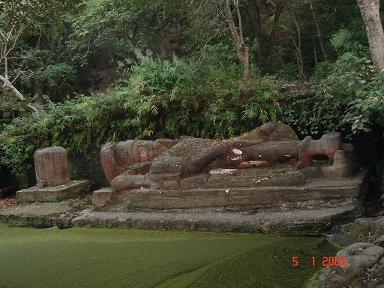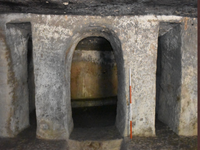Bandhavgarh
| Author:Laxman Burdak, IFS (R) |

Bandhavgarh (बांधवगढ़) is a village, site of an ancient fort and Bandhavgarh National Park in Umaria district of Madhya Pradesh, India.
Variants
Bandhavagarh (बांधवगढ़), म.प्र., (AS, p.616)
Origin
The Bandhavgarh fort derives its name from the most prominent hillock of the area, which is said to be given by Lord Rama to his brother Lakshmana to keep watch on Lanka. Hence the name Bandhavgarh (bandhav as brother, garh as fort).
Location
Bandhavgarh Fort

Bandhavgarh Fort is situated in Bandhavgarh in Umaria district of Madhya Pradesh, India. It is located on the Bandhavgarh hill, rising 811 meters above sea level at the centre of the Bandhavgarh National Park. It is surrounded by a large number of smaller hills separated by gently sloping valleys. These valleys end in small, swampy meadows, locally known as 'bohera'. The fort is also home to many of the endangered species of Vulture in India.
Jat clans
- Pandar - They are said to be descendants of Nagavanshi king Pandara (पाण्डर) /Pandaraka (पाण्डरक). (See - List of Naga Rajas).[1]
History
No records are available to show when Bandhavgarh fort was constructed. It is thought, however, to be some 2000 years old, and there are references to it in the ancient books, the "Narad-Panch Ratra" and the "Shiva Purana". Regional folklore suggests that Bandhavgarh Fort was constructed by rulers of the Gond Empire. Gond kings of the Pandro caste are the original builders of this fort, and descendants of Gond kings still live near the fort. Gond kings constructed 12 talab ponds, of which only few remain. This fort's construction and architecture are similar to other forts built by Gond Kings.
The Vanganga stream originates from Bandhavgarh Fort's hill. In Gondi language, van means surname and ganga loosely translates to a pure stream. That may suggest that Pandro, the surname of Gond kings, may have originated from "Vanganga" .
Bandhavgarh Fort was the business centre for the traders traveling between Kaushambi and Bharhut, at that time known as Bardawati (Bhaudhya root). During the Kalachuri dynasty it was called "Haihaya Kshetra". The Vakataka dynasty used this place, and various stone writings are found written by them. They made the place livable by cutting stones. There are some ruins found of the Fort in the Bamania Hill near Bandhavgarh, and there are many sculptures and coins found in the nearby villages near Bandhavgarh, Bijhariya, Mala which prove the economical and artistic situation of the kingdom. In the reign on Karan Deo (Vikram Samvat 1245-1260), Bandhavgarh was the capital of the southern part of the Gahora kingdom.
There are a few statues depicting the reincarnations of Vishnu (avatar) - like one of the Fish and another of the Turtle. There are some remaining ponds on the hill e.g. Rani Talab (Queen's Pond). There is a viewpoint on the hill called Suicide point, from which if one is lucky one can see the vultures in flight.
On the way back from the fort one can see a gigantic idol of Vishnu lying down, it is also known as Sesh Shai. The word Bandhavgarh means the Fort of Laxmana, and the stone carved Shesh Shai also provides further evidence for the origin of this name.
Various dynasties have ruled the fort: for example, Mauryans from the 3rd century BC, Vakataka rulers from the 3rd-5th century, Sengars from the 5th century, and the Kalachuris from 10th century. In the 13th century, the Baghels took over, ruling from Bandhavgarh until 1617, when Maharaja Vikramaditya Singh moved his capital to Rewa. The last inhabitants deserted the fort in 1935.
Throughout the tour of Bandhavgarh fort, wildlife such as tigers, cubs, and deer can be seen. In addition, many rare species of birds like Malabar pied hornbill, falcons, 4 species of vultures, and tortoises swimming can also be seen. At some point one can also see vulture nests from above. The hilltop is considered best for photography of flying birds due to the advantage of being positioned at the top. This makes the Bandhavgarh fort a worthwhile addition to a Bandhavgarh National Park wildlife tour.
As of approximately 2012, it is no longer possible to visit Bandhavgarh fort, as the M.P. Forest Department is no longer granting anyone permission to do so. Only the large Vishnu statue at the base of the fort can be visited at present.
ASI discovers 9th century treasures in Bandhavgarh

ASI discovers 9th century treasures after 85 years in Bandhavgarh, Madhya Pradesh - The Archaeological Survey of India (ASI), after a gap of nearly 85 years, has resumed exploration and documentation work of ancient caves, temples, remains of Buddhist structures, and statues of Vishnu Dashavataras in the Bandhavgarh reserve forest area of Madhya Pradesh. The last time such an exploration took place was in 1938, when the exercise was led by ASI archaeologist N P Chakravarti. [2]
Reports suggest that in course of the exploration, more than 26 temples, 2 monasteries, 26 caves, 2 votive stupas, 46 sculptures, 24 inscriptions as well as other scattered remains and 19 water structures were also recorded. Further, many rare chaitya-shaped doors, coins, etc., have also been discovered.
If reports are to go by, the exploration covered time period of kings Bhimsena, Maharaja Pothasiri, Maharaja Bhattadeva, whereas the places deciphered in the inscriptions are Kaushami, Mathura, Pavata (Parvata), Vejabharada and Sapatanaairikaa. The exploration also revealed remains from the Gupta period, such as door jambs, besides 26 ancient temples/remains of Kalachuri period, i.e. 9th-11th century AD.
Archeologists unearth 2,000-year-old society from tiger reserve in Bandhavgarh National Park
Another ancient structure was unearthed from MP's Bandhavgarh National Park which provided an evidence of a "modern society" that existed thousands of years ago
In a survey that started on April 1, archeologists found many archaeological treasures from the Bandhavgarh National Park in Madhya Pradesh. They unearthed paintings from the past, man-made waterbodies and a few other evidences to suggest that a modern society.
While noting of the findings, experts were quoted in a Times of India report as saying that the tiger reserve of the present day was once most likely part of an old trade route with passing traders using rock-cut caves as shelters.
Archeologists came across a 1,500-year-old rock painting and a plenty man-made waterbodies, which are believed to be no lesser than 1,800-2,000-year-old, from the national park in Madhya Pradesh.
"The presence of the waterbodies built at a height and used for collecting rainwater suggests the habitation had a modern society. The waterbodies could be 1,800-2,000 years old, but evidence suggests there was some renovation 1,000 years ago," an ASI official told the newspaper.
The zone has often made the headlines for what the land holds underneath. Last year, The Archaeological Survey of India (ASI) informed of unearthing 26 Buddhist caves in there after a long summer exploration. It was noted that the caves would date back to the 2nd-5th century BCE.
बाँधवगढ़
विजयेन्द्र कुमार माथुर[3] ने लिखा है....बाँधवगढ़ मध्य प्रदेश में स्थित और इतिहास प्रसिद्ध रीवा रियासत का पुराना नाम है। वास्तव में बाँधवगढ़, रीवा से दक्षिण की ओर कुछ दूरी पर स्थित है। यह स्थान अति प्राचीन है, जैसा कि दूसरी-तीसरी शती ई. के 23 अभिलेखों से ज्ञात होता है, जो पुरातत्व विभाग को 1938 में यहाँ से प्राप्त हुए थे। इन अभिलेखों की भाषा प्राकृत और संस्कृत का मिश्रण है। लिपि ब्राह्मी है। यहाँ से मिले अभिलेखों में महाराज 'वैशिष्टीपुत्त भीमसेन' तथा उनके पुत्र और पौत्र का उल्लेख है। अभिलेखों का विषय मथुरा तथा कौशांबी के वणिक्-गणों द्वारा दिए गए दान का वृत्तांत है। एक अभिलेख में व्यायामशाला बनावाए जाने का भी उल्लेख है, जिससे सूचित होता है कि इतने प्राचीन काल में भी जनता के स्वास्थ की ओर संघटित रूप से पार्याप्त ध्यान दिया जाता था। बाँधवगढ़, रीवा की प्राचीन राजधानी होने के कारण काफ़ी प्रख्यात नगर था और रीवा नरेश अपनी राजसी उपाधियों में अपने को बांधवेश कहलाना उचित समझते थे।

